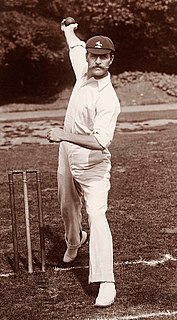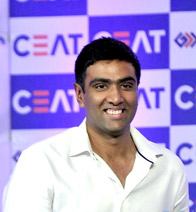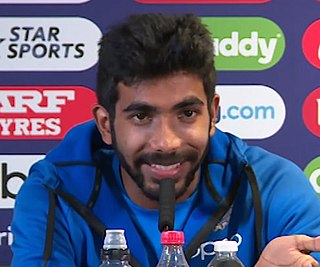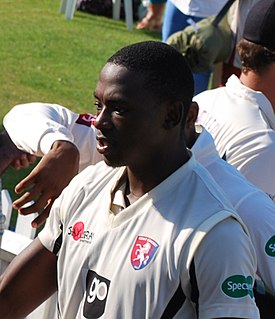Related Research Articles

The South Africa national cricket team, also known as the Proteas, represents South Africa in men's international cricket and is administered by Cricket South Africa. South Africa is a full member of the International Cricket Council (ICC), with Test, One-Day International (ODI) and Twenty20 International (T20I) status. Its nickname derives from South Africa's national flower, Protea cynaroides, commonly known as the "King Protea".

Makhaya Ntini OIS is a South African former professional cricketer, who played all forms of the game. He was the first Xhosa player play for the South African national cricket team.

George Alfred Lohmann was an English cricketer, regarded as one of the greatest bowlers of all time. Statistically, he holds the lowest lifetime Test bowling average among bowlers with more than fifteen wickets and he has the second highest peak rating for a bowler in the ICC ratings. He also holds the record for the lowest strike rate in all Test history.

George Henry Stevens "Harry" Trott was an Australian cricketer who played 24 Test matches as an all-rounder between 1888 and 1898. Although Trott was a versatile batsman, spin bowler and outstanding fielder, "it is as a captain that he is best remembered, an understanding judge of human nature". After a period of some instability and ill discipline in Australian cricket, he was the first in a succession of assertive Australian captains that included Joe Darling, Monty Noble and Clem Hill, who restored the prestige of the Test team. Respected by teammates and opponents alike for his cricketing judgement, Trott was quick to pick up a weakness in opponents. A right-handed batsman, he was known for his sound defence and vigorous hitting. His slow leg-spin bowling was often able to deceive batsmen through subtle variations of pace and flight, but allowed opposition batsmen to score quickly.

Alec Hearne was a member of the famous cricketing Hearne family. He played as a professional for Kent County Cricket Club between 1884 and 1906 and made one Test match appearance for England. He was an all-rounder who was named as one of Wisden's five Cricketers of the Year in 1894. His father, George played cricket for Middlesex during the 1860s and brothers George and Frank also played Test cricket, as did his cousin, John Thomas Hearne.
Ernest Austin "Barberton" Halliwell was a first-class cricketer, who played eight Test matches for South Africa between 1892 and 1902, including three as captain. He played as a wicket-keeper, and was the first to put raw steaks inside his gloves to protect his hands. At his peak, he was considered one of the best wicket-keepers in the world, and was named one of the Wisden Cricketers of the Year in 1905. He was particularly praised for standing close to the wickets, even against fast bowlers.

Dale Willem Steyn is a South African former professional cricketer who played for the South African Cricket Team. He is often regarded as one of the greatest fast bowlers of all time and the best Test bowler of his generation. During the 2007–08 season, Steyn achieved a tally of 78 wickets at an average of 16.24, and was subsequently rewarded with the ICC 2008 Test Cricketer of the Year Award. He was named one of the Wisden Cricketers of the Year in 2013, and Wisden Leading Cricketer in the World for the year 2013 in 2014's Wisden Cricketers' Almanack. He was featured in Wisden Cricketers of the Decade at the end of 2019. He also was included in the ICC Test Team of the Decade at the end of 2020.

Hashim Mahomed Amla OIS a former South African international cricketer who played for South Africa in all three formats of the game. Amla holds the record for being the fastest ever to score 2000, 3000, 4000, 5000, 6000 and 7000 ODI runs. He also became the fastest cricketer to reach 10 ODI centuries. Amla is an occasional off break bowler and was South Africa's Test captain from June 2014 to January 2016.

Holcombe Douglas "Hopper" Read was an English cricketer who played in one Test in 1935.

Durant Clifford "Dante" Parkin was a South African cricketer who played in one Test in 1892.

Arthur Lennox Ochse was a South African cricketer who played in three Tests in 1927–28 and 1929.
The inaugural South African cricket tour of England took place in the 1894 season.

Mohammad Imran Tahir is a Pakistani-born South African cricketer. A spin bowler who predominantly bowls googlies and a right-handed batsman, Tahir played for South Africa in all three forms of cricket, but preferred the white ball matches.

Ravichandran Ashwinpronunciation (help·info) is an Indian international cricketer. An all-rounder who bats right-handed and bowls right-arm off-break, he plays for Tamil Nadu in domestic cricket and Delhi Capitals in the Indian Premier League. He is the fastest Indian bowler to reach the 50-, 100-, 150-, 200-, 250-, 300-, 350- and 400-wicket mark in Test cricket in terms of number of innings. In 2016, he became the third Indian to win the ICC Cricketer of the Year award. Considered to be one of the best spin bowlers of his generation, he is currently the highest-ranked spinner in Test cricket, and the highest-ranked Test bowler for India on the ICC Player Rankings. He has won nine Man of the Series awards in Test cricket, which is the highest by an Indian cricketer.
Beuran Eric Hendricks is a South African professional cricketer who plays for the Cape Cobras. He is a left-arm fast bowler who plays for the Cobras and his native Western Province cricket team. He made his international debut for the South Africa cricket team in March 2014.

Yasir Shah is an international cricketer from Pakistan. He plays as a bowler, and is the joint-second fastest bowler in the history of Test cricket to take 100 wickets, as well as also being the fastest to pick up 200 wickets, having broken the previous record set by Australian bowler Clarrie Grimmett.

Jasprit Jasbirsingh Bumrah is an Indian international cricketer, who plays for the Indian national cricket team in all formats of the game. He was named in India's squad for its 2015–16 series against Australia, as a replacement to an injured; Mohammed Shami. He is the first Asian bowler to take 5 wickets in a test innings in South Africa, England and Australia during the same calendar year.

Kagiso Rabada is a South African international cricketer who plays all formats of the game. He made his South African debut in November 2014 in limited-overs cricket before going on to make his Test debut in November 2015. By January 2018, he had topped both the ICC ODI bowler rankings and the ICC Test bowler rankings aged 22. In July 2018, he became the youngest bowler to take 150 wickets in Tests.

Khaya Majola was a South African cricket player and administrator. A black African, Majola played cricket during the apartheid-era in South Africa. Early in his playing career, he was given opportunities by the South African African Cricket Board (SAACB) to play alongside white players in exhibition matches, and to play overseas in England. He soon rejected further offers from the SAACB, feeling that the matches were token gestures, and that they were using black players as tools to overturn the sporting boycott of apartheid South Africa, and enable the national team, consisting solely of white players, to be re-admitted into international cricket. This decision meant that Majola played almost all of his cricket in the Howa Bowl between 1973 and 1991, a non-racial tournament organised by the South African Cricket Board of Control (SACBOC), who supported the boycott. Matches were typically played on matting wickets in poor conditions; they were not considered to be of first-class status at the time, but were subsequently added to the records.
References
- 1 2 Marks, Vic (14 December 2009). "Makhaya Ntini shoulders the burden of being an icon with a smile". Guardian. Retrieved 14 December 2009.
- ↑ "The lost legacy of Krom Hendricks, South Africa's first great black cricketer". ESPNcricinfo.
- 1 2 'Fast... but black' from CricInfo.
- 1 2 3 4 5 6 7 8 Merrett, Christopher. "Hendricks, A. [Krom] (fl. 1892–1897)". Oxford Dictionary of National Biography. Retrieved 15 December 2009.
- ↑ Winch, Jonty. Too black to wear whites : the remarkable story of Krom Hendricks, a cricket hero who was rejected by Cecil John Rhodes's empire. Parry, Richard, 1956-. Cape Town. ISBN 978-1-77609-508-7. OCLC 1141777578.
- ↑ "Malays v WW Read's XI – WW Read's XI in South Africa 1891/92". Cricket Archive. Retrieved 15 December 2009.
- ↑ Gemmell, Jon (2004). The politics of South African cricket. London: Routledge. p. 85. ISBN 0-7146-5346-2.
- 1 2 Valentine, Sue (25 March 2007). "One man, one big boycott". Sunday Times (Cape Town). Archived from the original on 3 October 2011. Retrieved 15 December 2009.
- ↑ The story of an African game, André Odendaal, New Africa Books, 2003, ISBN 0-86486-638-0